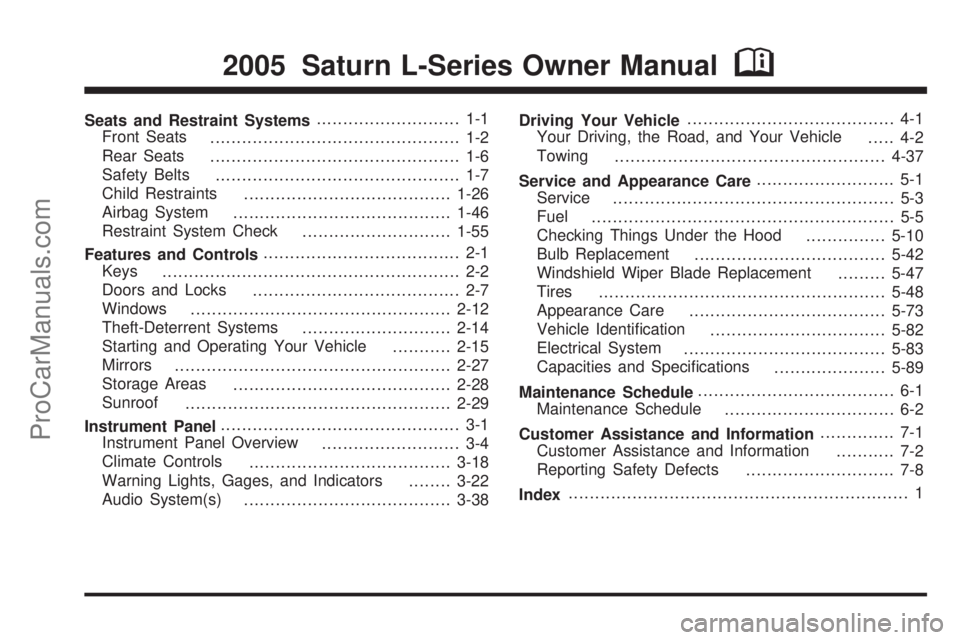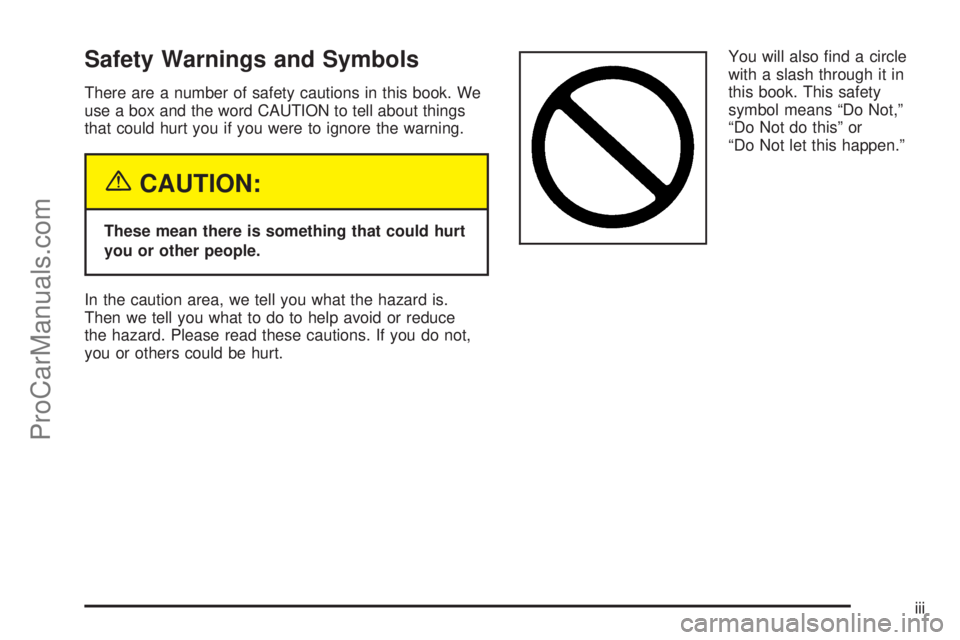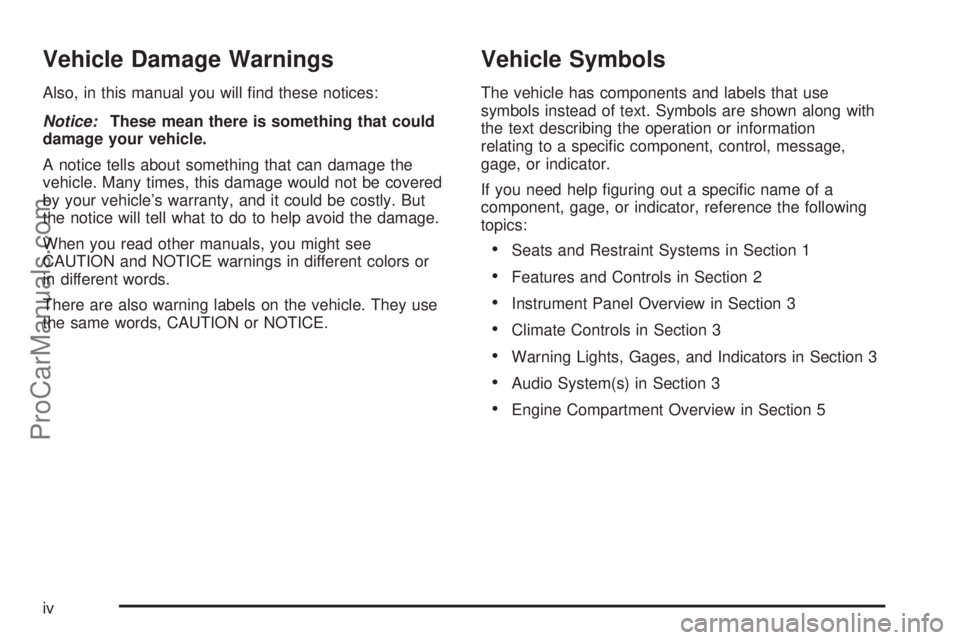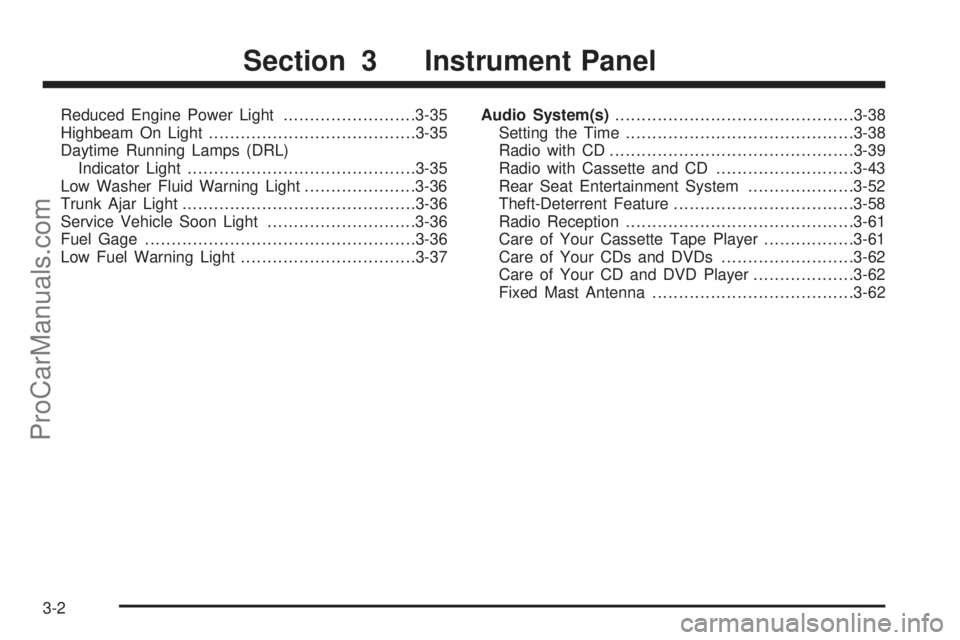warning SATURN L-SERIES 2005 Owners Manual
[x] Cancel search | Manufacturer: SATURN, Model Year: 2005, Model line: L-SERIES, Model: SATURN L-SERIES 2005Pages: 330, PDF Size: 2.4 MB
Page 1 of 330

Seats and Restraint Systems........................... 1-1
Front Seats
............................................... 1-2
Rear Seats
............................................... 1-6
Safety Belts
.............................................. 1-7
Child Restraints
.......................................1-26
Airbag System
.........................................1-46
Restraint System Check
............................1-55
Features and Controls..................................... 2-1
Keys
........................................................ 2-2
Doors and Locks
....................................... 2-7
Windows
.................................................2-12
Theft-Deterrent Systems
............................2-14
Starting and Operating Your Vehicle
...........2-15
Mirrors
....................................................2-27
Storage Areas
.........................................2-28
Sunroof
..................................................2-29
Instrument Panel............................................. 3-1
Instrument Panel Overview
.......................... 3-4
Climate Controls
......................................3-18
Warning Lights, Gages, and Indicators
........3-22
Audio System(s)
.......................................3-38Driving Your Vehicle....................................... 4-1
Your Driving, the Road, and Your Vehicle
..... 4-2
Towing
...................................................4-37
Service and Appearance Care.......................... 5-1
Service
..................................................... 5-3
Fuel
......................................................... 5-5
Checking Things Under the Hood
...............5-10
Bulb Replacement
....................................5-42
Windshield Wiper Blade Replacement
.........5-47
Tires
......................................................5-48
Appearance Care
.....................................5-73
Vehicle Identification
.................................5-82
Electrical System
......................................5-83
Capacities and Specifications
.....................5-89
Maintenance Schedule..................................... 6-1
Maintenance Schedule
................................ 6-2
Customer Assistance and Information.............. 7-1
Customer Assistance and Information
........... 7-2
Reporting Safety Defects
............................ 7-8
Index................................................................ 1
2005 Saturn L-Series Owner ManualM
ProCarManuals.com
Page 3 of 330

Safety Warnings and Symbols
There are a number of safety cautions in this book. We
use a box and the word CAUTION to tell about things
that could hurt you if you were to ignore the warning.
{CAUTION:
These mean there is something that could hurt
you or other people.
In the caution area, we tell you what the hazard is.
Then we tell you what to do to help avoid or reduce
the hazard. Please read these cautions. If you do not,
you or others could be hurt.You will also find a circle
with a slash through it in
this book. This safety
symbol means “Do Not,”
“Do Not do this” or
“Do Not let this happen.”
iii
ProCarManuals.com
Page 4 of 330

Vehicle Damage Warnings
Also, in this manual you will find these notices:
Notice:These mean there is something that could
damage your vehicle.
A notice tells about something that can damage the
vehicle. Many times, this damage would not be covered
by your vehicle’s warranty, and it could be costly. But
the notice will tell what to do to help avoid the damage.
When you read other manuals, you might see
CAUTION and NOTICE warnings in different colors or
in different words.
There are also warning labels on the vehicle. They use
the same words, CAUTION or NOTICE.
Vehicle Symbols
The vehicle has components and labels that use
symbols instead of text. Symbols are shown along with
the text describing the operation or information
relating to a specific component, control, message,
gage, or indicator.
If you need help figuring out a specific name of a
component, gage, or indicator, reference the following
topics:
•Seats and Restraint Systems in Section 1
•Features and Controls in Section 2
•Instrument Panel Overview in Section 3
•Climate Controls in Section 3
•Warning Lights, Gages, and Indicators in Section 3
•Audio System(s) in Section 3
•Engine Compartment Overview in Section 5
iv
ProCarManuals.com
Page 78 of 330

Ignition Positions
With the key in the ignition
switch, you can turn the
switch to four positions.
OFF:This is the only position from which you can
remove the key.
Notice:Using a tool to force the key from the
ignition switch could cause damage or break the
key. Use the correct key and turn the key only with
your hand. Make sure the key is in all the way. If
none of this works, then your vehicle needs service.ACC (Accessory):This is the position in which you
can operate your electrical accessories. With the key in
this position, the ignition and automatic transaxle will
unlock. Use this position if your vehicle must be pushed
or towed.
RUN:This is the position for driving to which the switch
returns after you start the engine and release the
switch. The switch stays in RUN when the engine is
running. But even when the engine is not running, you
can use RUN to operate your electrical accessories
and to display some instrument panel cluster messages
and warning lights.
START:This position starts the engine. When the
engine starts, release the key. The ignition switch will
return to RUN for normal driving.
2-16
ProCarManuals.com
Page 84 of 330

Parking Brake
To set the parking brake, hold the regular brake pedal
down with your foot and pull up on the parking brake
lever located between the seats. If the ignition is on, the
brake system warning light on the instrument panel
cluster will come on. SeeBrake System Warning Light
on page 3-27.To release the parking brake, hold the regular brake
pedal down. Pull the parking brake lever up until you can
press in the button at the end of the lever. Hold the
button in as you move the parking brake lever all the
way down.
Notice:Driving with the parking brake on can
overheat the brake system and cause premature
wear or damage to brake system parts. Verify that
the parking brake is fully released and the brake
warning light is off before driving.
If you are towing a trailer and you must park on a hill,
seeTowing a Trailer on page 4-40.
2-22
ProCarManuals.com
Page 93 of 330

Instrument Panel Overview...............................3-4
Hazard Warning Flashers................................3-6
Other Warning Devices...................................3-6
Horn.............................................................3-6
Tilt Wheel.....................................................3-6
Turn Signal/Multifunction Lever.........................3-7
Turn and Lane-Change Signals........................3-7
Headlamp High/Low-Beam Changer..................3-8
Flash-to-Pass.................................................3-8
Windshield Washer.........................................3-8
Windshield Wiper Lever...................................3-9
Cruise Control..............................................3-10
Headlamps..................................................3-13
Daytime Running Lamps (DRL).......................3-13
Automatic Headlamp System..........................3-14
Fog Lamps..................................................3-15
Instrument Panel Brightness...........................3-15
Dome Lamp.................................................3-16
Entry Lighting...............................................3-16
Map Lamps.................................................3-16
Battery Run-Down Protection..........................3-16
Accessory Power Outlets...............................3-16
Ashtrays and Cigarette Lighter........................3-17Climate Controls............................................3-18
Climate Control System.................................3-18
Outlet Adjustment.........................................3-20
Passenger Compartment Air Filter...................3-21
Warning Lights, Gages, and Indicators............3-22
Instrument Panel Cluster................................3-23
Speedometer and Odometer...........................3-24
Trip Odometer..............................................3-24
Tachometer.................................................3-25
Safety Belt Reminder Light.............................3-25
Airbag Readiness Light..................................3-26
Battery Warning Light....................................3-27
Brake System Warning Light..........................3-27
Anti-Lock Brake System Warning Light.............3-28
Traction Control System (TCS) Warning Light . . .3-29
Engine Coolant Temperature Warning Light......3-29
Engine Coolant Temperature Gage..................3-30
Low Coolant Warning Light............................3-30
Malfunction Indicator Lamp.............................3-31
Oil Pressure Light.........................................3-33
Change Engine Oil Light................................3-34
Security Light...............................................3-34
Section 3 Instrument Panel
3-1
ProCarManuals.com
Page 94 of 330

Reduced Engine Power Light.........................3-35
Highbeam On Light.......................................3-35
Daytime Running Lamps (DRL)
Indicator Light...........................................3-35
Low Washer Fluid Warning Light.....................3-36
Trunk Ajar Light............................................3-36
Service Vehicle Soon Light............................3-36
Fuel Gage...................................................3-36
Low Fuel Warning Light.................................3-37Audio System(s).............................................3-38
Setting the Time...........................................3-38
Radio with CD..............................................3-39
Radio with Cassette and CD..........................3-43
Rear Seat Entertainment System....................3-52
Theft-Deterrent Feature..................................3-58
Radio Reception...........................................3-61
Care of Your Cassette Tape Player.................3-61
Care of Your CDs and DVDs.........................3-62
Care of Your CD and DVD Player...................3-62
Fixed Mast Antenna......................................3-62
Section 3 Instrument Panel
3-2
ProCarManuals.com
Page 97 of 330

The main components of the instrument panel are the following:
A. Air Outlets. SeeOutlet Adjustment on page 3-20.
B. Turn Signal/Multifunction Lever. SeeTurn
Signal/Multifunction Lever on page 3-7.
C. Cruise Control. SeeCruise Control on page 3-10.
D. Horn. SeeHorn on page 3-6.
E. Instrument Panel Cluster. SeeInstrument Panel
Cluster on page 3-23.
F. Windshield Wiper Lever. SeeWindshield Wiper
Lever on page 3-9.
G. Fog Lamps (If Equipped). SeeFog Lamps on
page 3-15.
H. Hazard Warning Flasher Button. SeeHazard
Warning Flashers on page 3-6.I. Traction Control. SeeTraction Control System (TCS)
Warning Light on page 3-29.
J. Audio System. SeeAudio System(s) on page 3-38.
K. Trunk Release Button/Dimmer Switch. SeeTrunk
on page 2-10andInstrument Panel Brightness
on page 3-15.
L. Hood Release. SeeHood Release on page 5-11.
M. Climate Control. SeeClimate Control System
on page 3-18.
N. Automatic Transaxle Shift Lever. SeeAutomatic
Transaxle Operation on page 2-18.
O. Power Windows. SeePower Windows on page 2-13.
P. Glove Box. SeeGlove Box on page 2-28.
3-5
ProCarManuals.com
Page 98 of 330

Hazard Warning Flashers
Your hazard warning flashers let you warn others. They
also let police know you have a problem. Your front
and rear turn signal lamps will flash on and off.
The hazard warning
flasher button is located
near the center of the
instrument panel.
Your hazard warning flashers work no matter what
position your key is in, and even if the key is not in.
Press the button to make the front and rear turn signal
lamps flash on and off. Press the button again to
turn the flashers off.
When the hazard warning flashers are on, your turn
signals will not work.
Other Warning Devices
If you carry reflective triangles, you can set them up at
the side of the road about 300 feet (100 m) behind
your vehicle.
Horn
Press near or on the horn symbols on your steering
wheel pad to sound the horn.
Tilt Wheel
A tilt wheel allows you to adjust the steering wheel
before you drive. You can raise it to the highest level to
give your legs more room when you exit and enter
the vehicle.
The lever that allows you to tilt the steering wheel is
located on the left side of the steering column.
To tilt the wheel, hold the
wheel and pull the lever.
Then, move the wheel to a
comfortable position and
release the lever to
lock the wheel in place.
3-6
ProCarManuals.com
Page 105 of 330

Headlamps
The exterior lamp control is located in the middle of the
turn signal/multifunction lever.
O(Exterior Lamp Control):Turn the control with this
symbol on it to operate the exterior lamps.
The exterior lamp control has the following four
positions:
AUTO (Automatic):Turn the control to this position to
put the headlamps in automatic mode. AUTO mode
will turn the exterior lamps on and off depending upon
how much light is available outside of the vehicle.
;(Parking Lamps):Turn the control to this position
to turn on the parking lamps together with the
following:
•Sidemarker Lamps
•Taillamps
•License Plate Lamps
•Instrument Panel Lights
53(Headlamps):Turning the control to this
position turns on the headlamps, together with the
previously listed lamps and lights.
Lamps On Reminder
If you open the driver’s door with the ignition off and the
lamps on, you will hear a warning chime.
Daytime Running Lamps (DRL)
Daytime Running Lamps (DRL) can make it easier for
others to see the front of your vehicle during the
day. DRL can be helpful in many different driving
conditions, but they can be especially helpful in the short
periods after dawn and before sunset. Fully functional
daytime running lamps are required on all vehicles
first sold in Canada.
The DRL system will make your low-beam headlamps
come on at a reduced brightness in daylight when
the following conditions are met:
•The ignition is on,
•the exterior lamp band is in the AUTO position,
•the transaxle is not in PARK (P),
•the light sensor determines it is daytime, and
•the parking brake is released.
3-13
ProCarManuals.com